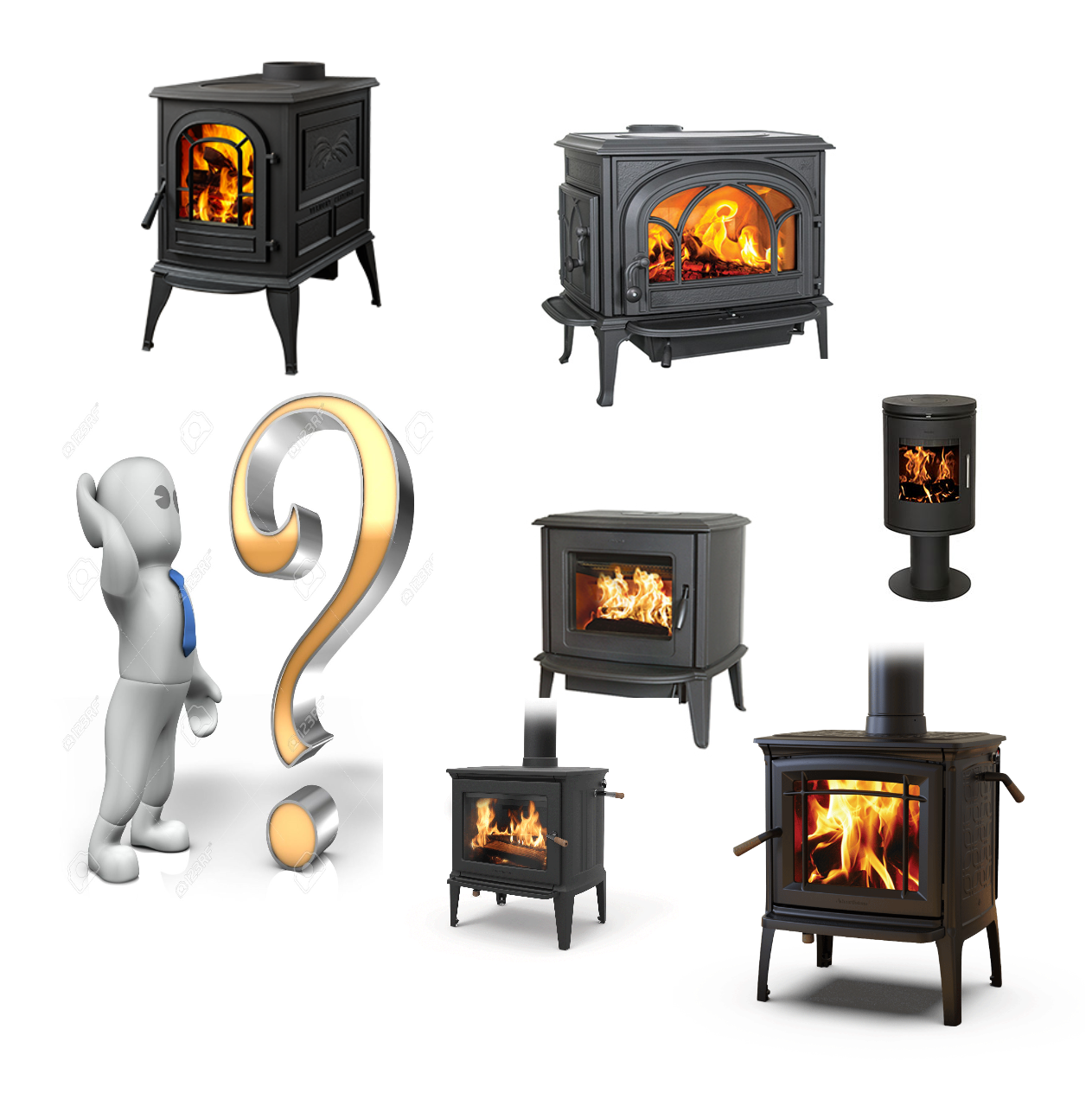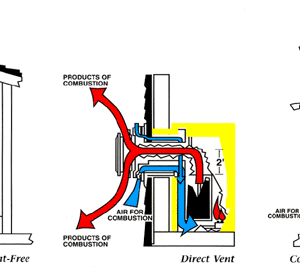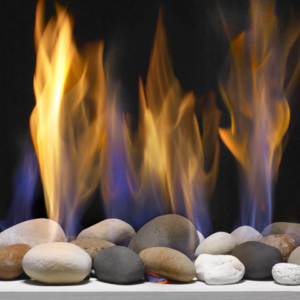Non-Catalytic, Hybrid & SBR Wood Appliances
Did you know that over half of the energy that comes from the burning of wood actually comes from the combustion of the flue gases and not the actual solid wood? It’s true! This is referred to as the secondary combustion of flue gases or gasification. Some appliances even have mechanisms where flue gases are burned three times, known as tertiary combustion. Catalytic combustors are one means by which stoves can burn flue gases, but there are other technologies as well. With all the different options and misinformation about there, it can be really confusing to pick the right wood stove and know you’re getting what you want. Here we discuss the predominant technologies associated with the combustion of flue gases that help your stove not only burn more efficiently, but also more cleanly in order to help you choose the right stove for you!
Today's EPA-Certified wood and pellet stoves are much cleaner burning than those from of decades past. Prior to the 1980s, there were no emissions standards created by the Environmental Protection Agency (EPA) for wood or pellet stoves, and as a result, stoves were much more dirty burning and inefficient. Pre-EPA certified stoves often emitted upwards of 80 grams per hour of particulate resulting in unclean air, and even dirtier and unsafe chimneys. Over the past forty years, the EPA has instituted various regulations on manufacturers of wood and pellet stoves, and in order to meet EPA emission standards, stove manufacturers began to develop various secondary burn technologies starting in the 1980s. Here we discuss some of these secondary combustion technologies that have helped wood and pellet stoves, fireplaces and inserts achieve thermal efficiency ratings upwards of 80% today, about eight times more efficient than traditional, masonry fireplaces and two to three times more efficient than wood stoves of the pre-1980s era.
Catalytic wood stoves, fireplaces and inserts. Despite being formally classified by the EPA as "catalytic wood stoves", none of the stoves that we sell at Mazzeo's are strictly catalytic wood stoves anymore as they used to be in the 1980s, 1990s and early 2000s. Today's "catalytic" wood stoves that we sell at Mazzeo's are really better classified as "hybrid wood stoves" that achieve the majority of the secondary combustion by some other means, and the catalytic combustor is simply added to give the stove one last boost to meet the EPA's 2020 hurdle. Moreover, since today's hybrid wood stoves do not rely strictly on the catalyst to burn the gases, when the catalyst degrades over time and needs replacing, the stove will continue to burn much more cleanly and efficiently compared to stoves of the 1980-2000 era that relied strictly on catalytic combustors. For example, Vermont Castings utilizes a secondary combustion chamber made of a high temperature refractory in their flagship line of wood stoves, which they call Flexburn technology. With Flexburn, flue gases are redirected into a secondary combustion chamber located in the stove's fireback where they are superheated and combust. In some cases, such as with the Vermont Castings Intrepid Flexburn, the secondary combustion chamber is adequate to achieve incredibly low emissions, well below the 2.5 gram per hour maximum, and the stove is classified by the EPA as non-catalytic as it does not need to use a catalyst at all. Even without the optional catalyst, the Intrepid Flexburn has a thermal efficiency of 74% and emits just .6 grams per hour, less than one fourth the maximum of 2.5 grams permissible per 2020 EPA emissions standards. With the optional catalyst placed into the combustion chamber to aid in the secondary combustion process, thermal efficiency is only increased by a mer 3% to to 77%, and it reduces emissions to 0.3 grams per hour. Thus, the catalyst is not even needed, and most customers don't buy the optional catalytic combustor for the Intrepid Flexburn, unless they are trying to take advantage of federal tax programs or a state rebate program that requires stoves have at least 75% thermal efficiency in order to participate, as we have seen in recent years. Other Vermont Castings stoves, such as the Encore and Defiant Flexburn, utilize the same combustion technology, but due to the larger mass of wood that they burn, they require a catalyst in the combustion chamber in order to achieve meet the 2.5 gram per hour or less standard. Since the Encore and the Defiant do come with a catalyst to meet their emissions standards, Encore and Defiant are technically considered "catalytic wood stoves", but this is a bit misleading as the catalyst helps very little. Moreover, previous editions of the Encore and Defiant that were introduced in the 1980s and 1990s actually were strictly catalytic wood stoves as they had no refractory combustion chamber at all. So, it is important that customers not confuse today's hybrid catalytic/non-catalytic stoves, such as the Encore and Defiant, with those of yesteryear. While older strictly catalytic wood stoves were efficient when properly maintained with functional catalysts, when the catalysts degraded, they lost much of their thermal efficiency and clean-burning properties.
Hybrid wood stoves, inserts and fireplaces utilize one technology to perform the bulk of the secondary combustion, such as baffle technology or a secondary burn chamber, and a catalyst to assist with the secondary combustion or by providing tertiary combustion. Capable of achieving thermal efficiencies upwards of 80%, hybrid wood stoves are the most advanced, cleanest burning, and efficient wood stoves to date. Hybrid wood stoves that we carry are made by Jotul with Fusion Technology, Hearthstone with TruHybrid Technology, Lopi with Hybrid-Fire Technology , Vermont Castings stoves with Flexburn Technology, and all Kuma wood stoves. Please note that many of these stove manufacturers make non-catalytic models as well that do not employ a catalyst at all, which we will discuss later on. Most hybrid wood stoves that we carry employ a technology referred to as "baffle technology" as they incorporate a baffle to achieve secondary combustion. A baffle is a device that slows something down, in this case the path of the flame as it leaves the stove. Baffles in wood stoves are essentially ceilings which redirect the flames by pitching them forward before making their way backwards to the rear of the stove where they exit the flue collar. Unlike older, pre-EPA ear wood stoves with cast iron baffles, today's EPA stoves with baffles also employ secondary air systems, which bring fresh air into the firebox under the baffle through stainless steel tubes, combustion tees, or into a hollow baffles known as a stepper baffle. By injecting fresh oxygen into the fire through these secondary air systems, greater thermal efficiency and lower particulate emissions are achieved. Baffle technology was the predominant technology used in wood stoves prior to the EPA's 2020 emission standards, and we commonly refer to these stoves as "pre-2020 EPA stoves" as opposed to the non-EPA certified stoves of the pre-1980 era. While these pre-2020 EPA stoves were still some twenty times cleaner burning than stoves of the pre-1980s era, wood stove manufacturers found it difficult to engineer stoves that could meet the more stringent 2020 standard of 2.5 grams per hour or less by using one sole secondary combustion technology. Thus, most wood stove manufacturers today have added catalytic combustors to their existing models simply in order to get them over the 2020 hurdle, and in doing so, today's hybrid wood stoves are among the most advanced, cleanest burning wood stoves ever designed. Most hybrid catalytic/non-catalytic wood stoves, such as Jotul's Fusion Technology, Hearthstone's TruHybrid Technology, Lopi's Hybrid-Fire Technology and Kuma wood stoves offer baffle and tube or baffle and tee secondary combustion technology to do the bulk of the secondary combustion, and a catalyst is place above the baffle near the flue collar to combust the gases one last time, thus offering tertiary combustion. With the exception of Jotul's Fusion Technology, Hearthstone, Lopi and Kuma all use bypass dampers and small catalytic combustor. Jotul's Fusion technology uses a large, patented catalyst that is over 90% free-flowing, thus no bypass damper is used, and it operates very much like its previous non-catalytic versions. Jotul also offers an industry-best 20 year warranty on their catalytic combustors. Of the hybrid stoves that we offer, only Vermont Castings stoves with Flexburn Technology, as discussed prior, does not use baffle technology, rather it uses a secondary combustion chamber to do the bulk of the secondary combustion, but this is consistent with how Vermont Castings stoves have always been as they are top-loading stoves.
Non-catalytic wood stoves today are essentially very similar to the pre-2020 EPA wood stoves using baffle technology that were available up until May of 2020, except with minor changes. For example, Jotul's pre-2020 F 45 Greenville wood stove had an emission rate of 2.3 grams per hour prior to 2020, but by using their Turbulator technology, the new F 45 v2 Greenville has a particulate emission rate of 1.8 grams per hour. Turbulator Technology essentially is achieved by mounting steel vees on top of the stepper baffle, which increase the flow of flue gases. Since thermal efficiency is a function of time, temperature and turbulence, the added turbulence created by the vees, much like the phenomenon of lift on an airplane wing, amounts to improved combustion and lower particulate emissions. Other manufacturers, such as Lopi with their NexGen-Fyre Technology, have found that by making minor adjustments to the pitch of the the baffle and the size of the holes in the combustion tubes, they have been able to redesign their stoves with baffle technologies to meet or exceed the 2020 EPA emissions standard. In some cases, such as with the Morso 6100-B series or the 7110-B, which use baffle technology, no discernible changes to the design were made at all. The non-catalytic Morso 6100B series are capable of attaining thermal efficiencies up to 77%, and they emit just .67 grams of particulate per hour, while the 7110-B has a thermal efficiency of 75% and an emission rate of just 1.1 gram per hour. This said, there is one form of non-catalytic technology that is rather different, and customers should be aware of it when making a purchase, and this is known as SBR or single-burn rate technology.
SBR or Single Burn Rate Stoves are typically non-catalytic stoves, fireplace inserts or zero-clearance fireplaces that have no primary air control to the stove. Primary air controls are distinguished from secondary air controls in that the user can adjust primary air, while secondary air is air that the stove regulates itself and the user cannot control. Some secondary air controls are automated through the use of a thermostatic air control constructed of a bi-metallic coil that relaxes upon reaching a certain temperature. When the coil relaxes, it opens or closes a secondary air shutter that allows more or less secondary air into the stove. Thus, to say that SBR stoves do not have any means of regulating the air is not entirely true as they typically have secondary thermostatic air controls, but the user cannot manually adjust the air to increase or decrease the burn rate. While some users are put off by the thought of not being able to control the primary air themselves, others users find that having one less thing to remember to be refreshing. Examples of SBR stoves that we sell would be the RSF Focus SBR zero-clearance fireplace and the Vermont Castings Aspen C3. When the Aspen C3 came out in 2019, we made sure to burn one in the shop to test it, and we were very pleased with the performance of the stove. In our experience, the stove gave out steady heat for a good six hours, and it did not overheat. Moreover, the glass stayed nice and clean, which is a testament to its clean-burning properties. While it is always nice to be able to control the primary air, as long as the stove burns well, that really is all that matters, and we believe that we will see more and more single burn rate stoves in the future, as well as new stoves with automated air controls, much as you would find in pellet stoves.
Choosing the right stove for you. When it comes to choosing the right stove for you, make sure to come by and take a look at the different stoves that we have to offer and to speak with our friendly and knowledgeable NFI-Certified sales staff. Our employees undergo annual professional development in the industry, and have been certified by the National Fireplace Institute in wood, gas and pellet burning appliances. We have been in hearth industry for fifty years, and we not only burn what we sell, we also own and use those very products in our own homes. We have over twenty burning displays in our shop, and when we take on new products, we make it a point to learn everything we can about them in order to better inform you, the customer. We have hybrid, non-catalytic and SBR stoves in the shop for you to take a look at, and we're happy to give you frank, honest advice about what would work well for you and why. We only carry the finest hearth products, and we are happy to help you find the right stove, fireplace or insert for you based on your budget, your habits, you interests and your needs!





